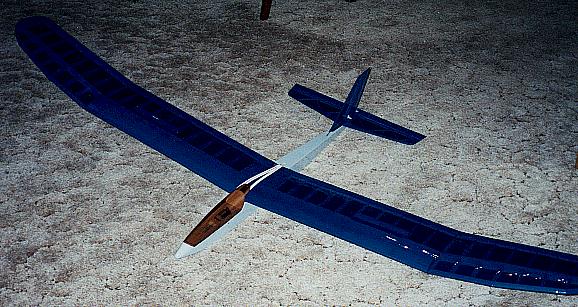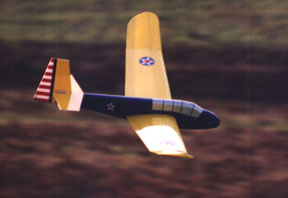Chapter 9: Beginner Sailplanes
9.1 Gentle Lady
The Gentle Lady (GL) is a proven design for beginners. Inexpensive, with easy all-wood construction, light weight, and a slow-flying flat bottom airfoil the GL is a great 2-channel, 2-meter polyhedral floater. The plane is quick, responsive, and can thermal in very light lift. It suffers somewhat on more windy days due to its slow flying speed, but it will easily ride on any small puff of lift on a calm day. The GL design dates back to the 1970's, and I believe more people have learned to soar using a Gentle Lady than any other plane in history. The Gentle Lady is also Nostalgia legal if you wish to someday compete in a Nostalgia contest.GL construction is fairly conventional wood design. I have seen many first-time builders create beautiful Gentle Ladies. The instructions are complete, and not too difficult to follow. The only major weakness in the plane is its spar system which can vibrate and even occasionally break on strong launches.
Recommended modifications and building tips:
- Extend the top sheeting on the wing to cover the full length of the inner wing panel. This will strengthen the wing and remove its tendency to vibrate on high speed launches.
- Add spoilers to the wing. Purchase some 1" trailing edge stock and some nylon tubing. Ask a friend to show you the plans for a Spirit 2m to get an idea of what a simple spoiler system might look like.
9.2 Spirit 2M

I built my first Spirit in 1996, and had over 250 flights on it before an accidental radio mix-up resulted in high-speed vertical contact with a piece of really hard asphalt. I really enjoyed the plane, and placed in two local contests with it (one an unlimited class competition). It is a bit hard to fly well for some beginning pilots, because it does have a larger speed range. For top performance, move the CG and towhook to the rear a bit from where it is marked on the plans. The CG can move as far as 1/2" back from the spar. Overall, I think it's a great value for the price, and a fantastic first or second airplane.
Recommended modifications and building tips:
- Build the spoiler option, even if you don't plan to use it. You will probably want to add spoilers later, and this is really difficult to do once the wing has been finished. The hardware for the spoiler option cost less than $3 to purchase from your local hobby shop.
- On the two piece wing, be sure to wrap the inner wing joiner boxes thoroughly with strong thread or kevlar thread and soak with thin CA. If you fail to wrap the joiner boxes, they will self-destruct the first time you perform a hard launch.
- The CG on the plans is very conservative. The plane will fly much better if you press the CG to the rear as much as 1/2" behind the spar. Begin with the CG at the rear edge of the spar, and slowly remove weight until the plane gets difficult to handle.
9.3 DAW TG-3

The TG-3 produced by Dave's Aircraft Works started a revolution in sailplane training as the first foamie thermal trainer. Until 1997, EPP foamies were primarily used for slope combat, and no one marketed a tough EPP trainer for thermal fliers. Though not as light as wood trainers, EPP foamies are nearly indestructible. They will take an unbelievable amount of punishment and continue to fly. A semi-scale mock-up of a World War II army trainer, the TG-3 may not be the sleekest looking plane at the field. The plane has a 72" wing span, weighs around 36 oz, and can be built in a polyhedral or straight-wing aileron configuration.
The TG-3 is much quicker to build than a conventional wood plane, and has excellent instructions for the first time builder. Total construction from start to finish could be as little as 10-15 hours. The kit comes complete with all of the hardware to finish the polyhedral (two channel) version, and can be configured for three channels with only a few additional parts. The only items needed to finish the kit are basic tools, radio, packing tape, glues, and covering. Construction consists of installing the spar and trailing edge to the wing, cutting slots to install your radio, and some minor shaping. Portions of the foam plane are then wrapped with strapping tape for strength and covered with a conventional low temperature covering such as ultracote. The wrapping and covering is a bit of a mess, since all foam must be sprayed with 3M 377 glue to make the tape and covering adhere. Still, the TG-3 is much closer to an Almost-Ready-to-Cover (ARC) than a conventional kit.
I built a TG-3 for my daughter in 1997, and found it to be a lot of fun to build and fly. It flies faster than a wood trainer and does not float in light air as well due to its heavier wing loading. Nevertheless, the slight loss in performance is more than made up for in survivability. The plane is very tough, and it gives the beginner a chance to make mistakes without paying a heavy price. You can hand catch the plane by the wing, stall it, hit light poles and trees, almost anything with little fear of doing damage. Many intermediate fliers use the aileron version TG-3 as a transition plane to learn aileron flying. Former World champ Joe Wurts put everyone on notice when he won the 1997 Pasadena Soaring Festival 2-meter class with a TG-3 -- demonstrating that it's the pilot and not the high performance plane that matters.
Recommended modifications and building tips:
- It takes a lot of lead to balance the plane properly if you position your radio equipment as shown on the plans. If possible, move your radio equipment forward so you can reduce the amount of nose weight you will add. Also, place a few extra wraps of tape on the nose. This puts some of the nose weight to good use.
- The only item that has broken on my TG-3 is the arms on the tail feathers. When the TG-3 hits very hard on its nose, the foam fuselage compresses more than the nylon control rods, resulting in a lot of force on the servos and linkages. I strongly recommend putting a Z-bend in the control rods to absorb some impact. A better solution is to install Kimbrough servo savers (rotary type) on the servos to absorb linkage impact.
- Some toying with CG and tow hook position is required. The CG on the plans is actually very close to where you want it. The TG-3 is one of the few planes that does not benefit much from a far rearward CG. I drilled a series of 1/16" holes in the tow hook block to adjust the tow hook position. On my TG-3, the CG is very close to the spar, and tow hook is slightly forward of the position shown on the plans.